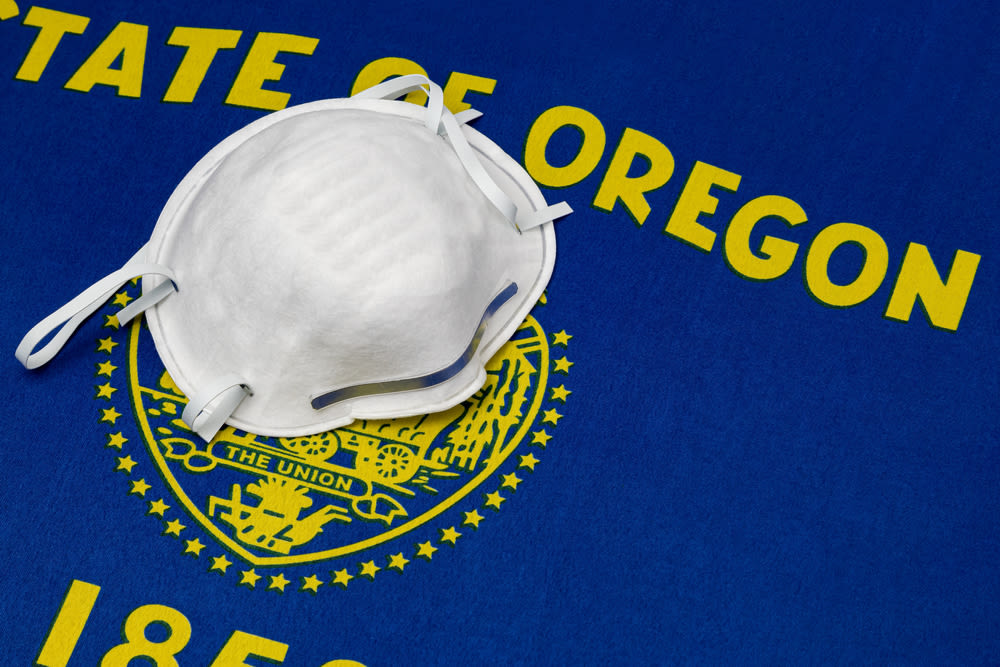Multnomah County’s Mask Mandates May Stick Around Until Spring of 2022

Oregon's current mask mandate is in place until February 8, but state health authorities have not yet said what metrics might influence whether it is extended or rolled back.
Image: J.J. Gouin/Shutterstock
Portlanders should prepare for the possibility of having to wear their masks indoors in public spaces at least until the spring of 2022, Multnomah County’s top public health official told Portland Monthly this week.
But any specific metrics for lifting the mask mandates remain unclear, with state health authorities relatively tight-lipped on the question.
“We do not have specific metrics, as there are so many items with potential impacts," says Rudy Owens, a spokesperson for the Oregon Health Authority. "OHA expects population immunity in Oregon to steadily improve, especially with vaccination likely expanding to younger children and booster doses now being given. There are many variables involved in transmission, including community variation in vaccination rates, variation in adherence to preventive behaviors, (such as) masking, distancing and avoiding large gatherings, and new variants that could emerge. So there is not a particular level of population immunity at which point we can assume the virus will stop spreading.”
Oregon is now one of just five states, plus Puerto Rico and Washington, DC, with an indoor mask mandate on the books after Tuesday’s announcement from the governor of Louisiana that his state would drop its mask requirement for at least the next month, thanks to a steep drop in COVID-19 case numbers and hospitalizations.
Oregon’s statewide mandate has been in place since August 13; it’s due to expire on February 8. Since the mandate was put in place, case counts in the state have declined for eight straight weeks, and hospitalizations due to COVID have fallen by nearly half.
Not setting clear guidelines for lifting mandates takes a toll, says Dr. Jeanne Noble, an associate professor of emergency medicine and the director of COVID response at the University of California-San Francisco’s Parnassus Emergency Department.
“It creates almost learned helplessness—it's really psychologically discouraging to not know what the metrics are,” she says. “It's like running a race, but not knowing how many more miles you have to go, (so you think) maybe I should start walking, because I can't do this forever. And it discourages things like vaccine uptake. We need to know what the goal is we're working towards, and when we're going to achieve it. If it’s wrong, it can be revised, but people need to be able to pace themselves.”
The four other states with current indoor mask mandates are Washington, Hawaii, Illinois, and New Mexico; Oregon is the only state in the country with an outdoor mask mandate that applies regardless of crowd size.
Hawaii’s governor has said that COVID restrictions will be lifted by the end of the year, assuming that by then statewide case counts stay below 100 per day. In Illinois, Governor JB Pritzer has set the holidays as a goal for lifting restrictions; in the city of Chicago, mandates will be lifted once cases are below 200 per day, health officials say—or in a few weeks, according to the Windy City’s current trajectory.
Oregon health officials have been less specific, but there have been some breadcrumbs. In a press conference on August 11, Oregon Health Authority Director Pat Allen said that lifting the mask mandate would be “driven by the rapidity of transmission of the virus in the community and the impact it is having on hospitals. If we can get past the extreme lack of space in hospitals that we are facing in the coming weeks, we would come back and recommend potential changes to the mask rule.”
Then, just last week, in conversation on Oregon Public Broadcasting’s Think Out Loud, Allen suggested that instead of hospitalizations and testing results, vaccination was the key metric, saying that the state needed to see, “a rate of vaccination that breaks the linkage between cases and hospitalizations. We need to increase that rate of vaccination to be able to think about what the next phase of the pandemic looks like.”
Seventy-nine percent of Oregonians ages 12 and up are currently either fully vaccinated or in between their first and second shot, though there are pockets in the state where vaccination levels are far lower. Meanwhile, vaccinations for ages 5-11 could be available as soon as next week, after a Food and Drug Administration advisory panel gave its blessing on Tuesday.
The state has given even fewer hints about whether the outdoor mandate could be rolled back any earlier, though research shows that outdoor transmission of COVID-19 is extremely low. The outdoor mask mandate was put in place in response to concerns about outdoor events like the Pendleton Round-up and college football games, though college football nationally has not led to spikes this fall and health officials in Umatilla County have said the post rodeo spike there was "brief" though significant. Outdoor events that have been tied to outbreaks, like the Sturgis Motorcycle Rally, often include a high proportion of unvaccinated attendees who are spending significant time indoors at bars and restaurants together before or after events.
Oregon health officials and Gov. Kate Brown have been burned before by setting firm metrics and sticking to them. The mask mandate was revoked to great fanfare in late June of 2021 when about 70 percent of Oregonians 18 and older had gotten at least their first shot. The state abruptly reversed itself six weeks later when the delta variant was spreading rapidly around the state, sending hospitalization numbers to their highest point of the entire pandemic.
In an interview this week, Dr. Jennifer Vines, the Multnomah County Health Officer said masks may be a reality in Portland until, at least, this spring, when the cold and respiratory flu season subsides. The region is a victim of poor timing, she says: the delta variant wave and the COVID-19 threat may be slowly receding, but kids are back in school in time for cold and flu season to ramp up, and hospitals are dealing with a backlog of delayed procedures plus hit-and-miss staffing shortages as a result of vaccine mandates for employees (and burned-out health care system workers).
Add that to Oregon’s already lowest-in-the-nation number of staffed hospital beds—because the state has focused its resources instead on preventative care designed to keep people out of hospitals—and caution in the form of masks through the winter is warranted, in order to buffer hospitals from another potential surge, Vines says, especially since Portland’s hospitals serve the critically ill from around the entire state.
“I think we are going to stay vigilant around respiratory disease in general through the winter months for the sake of health care,” she says. “Masks in schools would probably help prevent some of the trading of the more typical childhood viruses this winter. With no other variant taking delta’s place, there is room for optimism heading into the spring of 2022. One way or another, we will get to that level of community protection, where we feel like it is ok to peel off some of those restrictions.”
Noble, though, says that there are costs to prolonged masking after the wide availability of vaccines to all age groups.
“I think that the quality of education, especially with our youngest learners, really suffers,” she says. “It’s helpful for them to see the expressions of the faces of their teachers, and their language acquisition is better. It’s especially hard for English Language Learners, for kids who have any kind of speech impediment or learning challenges. If it’s no longer doing anything measurable in terms of preventing serious illness or death, then we shouldn’t have (masks) as an abundance of caution when we know that our most disadvantaged children can be negatively affected.”
Looking ahead, Vines says she’s focused on testing positivity as a useful guideline—in Multnomah County, this has just dipped below 5 percent, which the CDC considers “moderate risk” territory. And though the virus is unpredictable and Brown’s February 8 deadline is still more than three months away, Vines says she expects that a final decision on lifting the indoor mask mandate will ultimately rest with individual counties.
For now, she says, local public health officials are preparing to offer more clarity, to explain, “what is the goal, and how do we know when we are there, as opposed to saying ‘Not yet, not yet.’ It is probably months away because of our unique timing, but we owe it to the public to explain what we are doing.”




